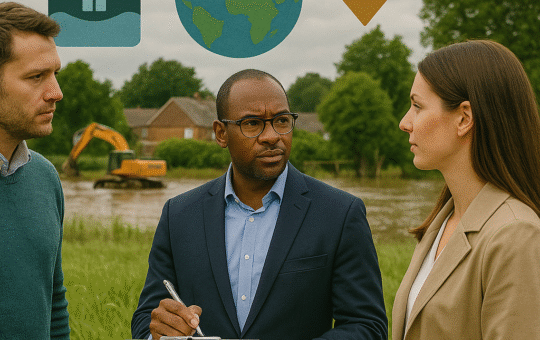Expert

Level 6 Diploma in Advanced Environmental Management and Policy Development
Level 6 Diploma in Advanced Environmental Management and Policy DevelopmentCourse OverviewThe Level 6 Diploma in Advanced Environmental Management and Policy Development is a specialized qualification designed for professionals looking to enhance their expertise in environmental management, policy development, and sustainable development practices. This diploma offers an in-depth understanding of the complex environmental challenges faced by governments, organizations, and communities. It equips learners with the skills needed to design, implement, and evaluate environmental policies that promote sustainability, resilience, and compliance with regulations. This course is perfect for individuals aiming for leadership roles in environmental management and policy development.Benefits
Who is This Designed For?This diploma is ideal for:
- Gain advanced knowledge of environmental management frameworks, systems, and policies.
- Learn how to develop, implement, and assess environmental policies in various sectors.
- Understand global environmental challenges, including climate change, biodiversity loss, and resource depletion.
- Develop skills to influence and shape environmental policy at local, national, and international levels.
- Build expertise in sustainable development, natural resource management, and environmental law.
- Enhance career opportunities in environmental policy, management, and leadership roles.
- Develop and manage advanced environmental management systems in line with best practices and regulations.
- Design and evaluate environmental policies addressing issues such as climate change, waste management, and biodiversity conservation.
- Understand the legal and regulatory frameworks for environmental protection at national and international levels.
- Analyze and interpret environmental data to inform policy decisions and management strategies.
- Lead environmental risk assessments and integrate sustainability into organizational operations.
- Implement corporate social responsibility (CSR) and sustainability strategies within organizations.
- Communicate complex environmental issues effectively to stakeholders, including policymakers, the public, and business leaders.
- Advise on the development of regulations and legislation to address emerging environmental issues.
- Introduction to Advanced Environmental Management
- Overview of environmental management: principles, systems, and frameworks.
- The role of environmental management in sustainable development and corporate governance.
- International environmental agreements and treaties: United Nations Framework Convention on Climate Change (UNFCCC), Paris Agreement, Biodiversity Convention.
- Environmental management systems (EMS): ISO 14001 and other standards.
- Environmental risk management: assessing and mitigating environmental risks.
- Best practices in environmental management in sectors such as energy, manufacturing, agriculture, and urban development.
- Policy Development and Environmental Governance
- Understanding the policy development process: from problem identification to policy implementation and evaluation.
- The role of government, NGOs, and the private sector in environmental policy creation.
- Environmental governance structures and models: international, national, and local levels.
- Regulatory frameworks for environmental protection and sustainable development.
- Policy tools and instruments: regulations, incentives, subsidies, and market-based mechanisms.
- Analyzing the impact of environmental policies on industries, communities, and ecosystems.
- Environmental Laws and Regulations
- The role of environmental law in sustainability and governance.
- Key environmental laws and regulations at national and international levels (e.g., the Clean Air Act, the Water Framework Directive, the National Environmental Policy Act).
- Compliance and enforcement mechanisms in environmental law.
- Environmental law for businesses: understanding compliance and the legal risks of environmental violations.
- Environmental impact assessments (EIA) and strategic environmental assessments (SEA).
- The relationship between environmental law and human rights, public health, and social justice.
- Climate Change Policy and Strategy Development
- Understanding the science and impacts of climate change: causes, effects, and projections.
- Global climate change agreements: Kyoto Protocol, Paris Agreement, and COP negotiations.
- Developing national and regional climate change policies and action plans.
- Mitigation strategies: reducing greenhouse gas emissions through energy efficiency, renewable energy, and carbon sequestration.
- Adaptation strategies: building resilience in communities, infrastructure, and ecosystems.
- The role of businesses and industries in climate change action and corporate climate responsibility.
- Natural Resource Management and Biodiversity Conservation
- Managing natural resources: water, land, minerals, and energy.
- Biodiversity conservation: importance, threats, and sustainable management practices.
- Strategies for sustainable land use and forest management.
- The role of ecosystems and ecosystem services in human well-being.
- Implementing policies for sustainable agriculture, fisheries, and forestry.
- Conservation policies for endangered species and habitats.
- Managing and protecting natural heritage sites and protected areas.
- Sustainable Development and Global Environmental Challenges
- Understanding the link between sustainability and environmental management.
- The United Nations Sustainable Development Goals (SDGs) and their implications for policy development.
- Sustainable development practices in urban planning, transportation, and infrastructure.
- Circular economy principles: reducing waste, promoting recycling, and resource efficiency.
- Addressing global environmental challenges: pollution, deforestation, ocean degradation, and resource depletion.
- The role of innovation and technology in sustainable development.
- Environmental Risk Assessment and Impact Evaluation
- Introduction to environmental risk assessment (ERA) and its importance in policy and decision-making.
- Identifying environmental hazards, vulnerabilities, and impacts.
- Methods and tools for environmental risk analysis: quantitative and qualitative techniques.
- Environmental impact assessments (EIA) for development projects and major infrastructure.
- Evaluating environmental risks and integrating findings into policy development.
- The role of stakeholder engagement in risk assessment and environmental decision-making.
- Stakeholder Engagement and Environmental Communication
- The importance of stakeholder engagement in environmental management and policy development.
- Identifying and mapping stakeholders: communities, businesses, government agencies, NGOs.
- Techniques for engaging stakeholders in environmental decision-making and policy development.
- Communicating complex environmental issues to diverse audiences: policymakers, the media, the public, and businesses.
- Public participation and consultation processes in environmental governance.
- The role of media and advocacy groups in influencing environmental policy and public opinion.
| Unit Title | GLH | TQT | Credit | Assessment Type |
| Introduction to Advanced Environmental Management | 30 | 50 | 5 | Assignment-Based |
| Policy Development and Environmental Governance | 30 | 50 | 5 | Assignment-Based |
| Environmental Laws and Regulations | 30 | 50 | 5 | Assignment-Based |
| Climate Change Policy and Strategy Development | 25 | 45 | 4 | Assignment-Based |
| Natural Resource Management and Biodiversity Conservation | 25 | 45 | 4 | Assignment-Based |
| Sustainable Development and Global Environmental Challenges | 25 | 45 | 4 | Assignment-Based |
| Environmental Risk Assessment and Impact Evaluation | 25 | 45 | 4 | Assignment-Based |
| Stakeholder Engagement and Environmental Communication | 20 | 40 | 3 | Assignment-Based |
- Environmental managers, officers, and directors who want to advance their career in policy development and environmental leadership.
- Government officials, policymakers, and advisors working in environmental planning, regulation, and sustainability.
- Consultants and professionals in the private sector focused on environmental compliance, policy, and risk management.
- NGO leaders and advocates working on environmental issues and policy reform.
- Individuals pursuing roles in international environmental organizations or governmental bodies focused on sustainability and climate change.
- Move into senior roles such as Environmental Policy Advisor, Senior Environmental Manager, or Policy Analyst.
- Take on leadership positions in government agencies, non-governmental organizations, or international bodies focused on environmental issues.
- Work as an environmental consultant, advising organizations on environmental policies, risk management, and sustainability practices.
- Lead climate change adaptation and mitigation programs or contribute to environmental lawmaking and regulation.
- Further studies in environmental policy, sustainability, or international environmental law at the postgraduate level.
- Expert-Led Learning: Learn from professionals with expertise in environmental management, policy, and law.
- Practical Insights: Apply knowledge to real-world environmental challenges through case studies, projects, and simulations.
- Global Perspective: Understand environmental policies and governance structures at local, national, and international levels.
- Globally Recognized Qualification: Enhance your credibility with a qualification respected worldwide.
- Career-Focused: Gain the skills to lead in high-level environmental management and policy roles.
Qualification Title:
Level 6 Diploma in Advanced Environmental Management and Policy Development
Level: 6
Type: Diploma
Total Qualification Time (TQT): 420 hours
Guided Learning Hours (GLH): 210 hours
Credit Value: 42 credits
Assessment Method: Assignment-Based
Grading: Pass/Fail
Delivery Mode: Online / In-Person / Blended
Study Units Breakdown
| Unit Title | GLH | TQT | Credit | Assessment Type |
| Introduction to Advanced Environmental Management | 30 | 50 | 5 | Assignment-Based |
| Policy Development and Environmental Governance | 30 | 50 | 5 | Assignment-Based |
| Environmental Laws and Regulations | 30 | 50 | 5 | Assignment-Based |
| Climate Change Policy and Strategy Development | 25 | 45 | 4 | Assignment-Based |
| Natural Resource Management and Biodiversity Conservation | 25 | 45 | 4 | Assignment-Based |
| Sustainable Development and Global Environmental Challenges | 25 | 45 | 4 | Assignment-Based |
| Environmental Risk Assessment and Impact Evaluation | 25 | 45 | 4 | Assignment-Based |
| Stakeholder Engagement and Environmental Communication | 20 | 40 | 3 | Assignment-Based |
Upon completing this diploma, learners will be able to:
- Develop and manage advanced environmental management systems in line with best practices and regulations.
- Design and evaluate environmental policies addressing issues such as climate change, waste management, and biodiversity conservation.
- Understand the legal and regulatory frameworks for environmental protection at national and international levels.
- Analyze and interpret environmental data to inform policy decisions and management strategies.
- Lead environmental risk assessments and integrate sustainability into organizational operations.
- Implement corporate social responsibility (CSR) and sustainability strategies within organizations.
- Communicate complex environmental issues effectively to stakeholders, including policymakers, the public, and business leaders.
- Advise on the development of regulations and legislation to address emerging environmental issues.
This diploma is ideal for:
- Environmental managers, officers, and directors who want to advance their career in policy development and environmental leadership.
- Government officials, policymakers, and advisors working in environmental planning, regulation, and sustainability.
- Consultants and professionals in the private sector focused on environmental compliance, policy, and risk management.
- NGO leaders and advocates working on environmental issues and policy reform.
- Individuals pursuing roles in international environmental organizations or governmental bodies focused on sustainability and climate change.
Assessment Type: Assignments Based
Top Courses
Related Courses
Let's Get in touch
Deleting Course Review
Are you sure? You can't restore this back
Course Access
This course is password protected. To access it please enter your password below:



